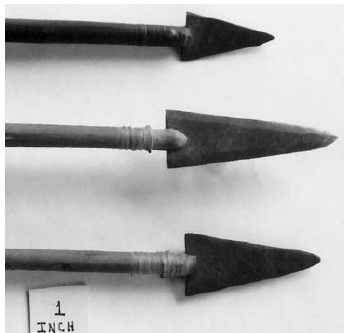|
Thoughts and Artifacts Relating to the Battle of the Little Bighorn |
by Ted Koelikamp, |
| Central States Archaeological Societies 2019
January Journal |
Crown Point, Indiana |
|
This is an excerpt from "Thoughts and
Artifacts Relating to the Battle of the Little Bighorn".
Read the complete column in the Central
States Archaeological Societies 2019
January Journal which can be purchased on-line after March 2020
|
|
|
|
|
In the last 150 years, much has been written
about the Battle of the Little Bighorn, otherwise known
as “Custer’s last Stand.” There have been many conflicting
reports, both by participants and historians on what
really happened and why the U.S. military lost. The end
result is known, with 268 U.S. Cavalryman killed, 59
wounded and 25 missing. On the American Indian side,
it is estimated that 150 warriors were lost, but that figure
is only conjecture.
Custer’s defeat was not the worst loss of the
U.S. military against the American Indians, but it is the
most remembered. Most notably, in 1791, under General
St. Clair, more than 1000 soldiers were killed along with
200 additional camp followers in a campaign against a
coalition of American Indian led by Little Turtle. This
engagement, known as the Battle of the Wabash, is considered
the worst defeat for the U.S. Army in the history
of the North American Indian wars.
It has been estimated that there were about
3000 warriors in the Little Bighorn battle compared to
nearly 600 soldiers. The real disparity, however, was
not so much in numbers as in the wide distribution of
troopers and in fire power. It is thought that nearly half
of the American Indian combatants had guns and about
half of those, nearly 750, had repeating arms such as
Sharps, Spencers, Henrys and Winchesters. The soldiers,
on the other hand, had the single shot breech loading
45/55 carbine (Model 1873), which had a limited
range. It was later reported that the soldiers had trouble
ejecting the carbine cartridges due to verdigris (green
corrosion) build up in the leather loops of their cartridge
belts and the resulting deposits on the brass cartridges.
They had to use pocket knives to pry out the cartridges
from the heated barrels. They also carried Model 1872
Colt single action Army issued six shot pistols, but these
were only good at close range. This was proven true as
archaeological investigations in the 1980s showed they
were only used during the closing moments of the battle
as evidenced by these being found mostly on and around
Custer Hill.
The American Indians, based on field research
(metal detecting) during the 1984-85 seasons, remained
in groups off at a distance and behind hills, pouring fire
down onto Custer’s group of 13 officers and 208 men until they were
quite decimated. Only after most of
Custer’s men were either dead or wounded did the
American Indians charge and overwhelm them.
Luckily, Major Reno and Captain Benteen
with 16 officers with 274 men between them, eventually
dug into a hill about 4 ½ miles to the east of Custer.
One attempt to reach Custer by a detachment of troopers
under the command of Captains Weir and Benteen
was driven back to their bluff position. Custer’s position
had already been overrun around that same time. Reno
and Benteen were able to hold off the warriors from this
bluff position until reinforcements arrived under the
command of General Terry from the west. Terry and his
men were the first to find the scattered nude and mutilated
bodies of Custer’s command. Only the trumpeter,
John Martini, survived because he was sent back to the
pack train to tell them to hurry with ammunition.
Read the complete column in the Central States Archaeological Societies 2019
January Journal which can be purchased on-line after March 2020

|
| The representative arrows shown in Figure 2,
have metal points which are typical of those used in the
battle. These cut metal points were either made by the
American Indians or obtained from traders. The points
were tied to the shaft with sinew and each arrow had
identifying marks and the colors of the owner. |
| |
| Read the complete column in the Central States Archaeological
Societies 2019 January Journal which
can be purchased on-line after March 2020 |
|
|




